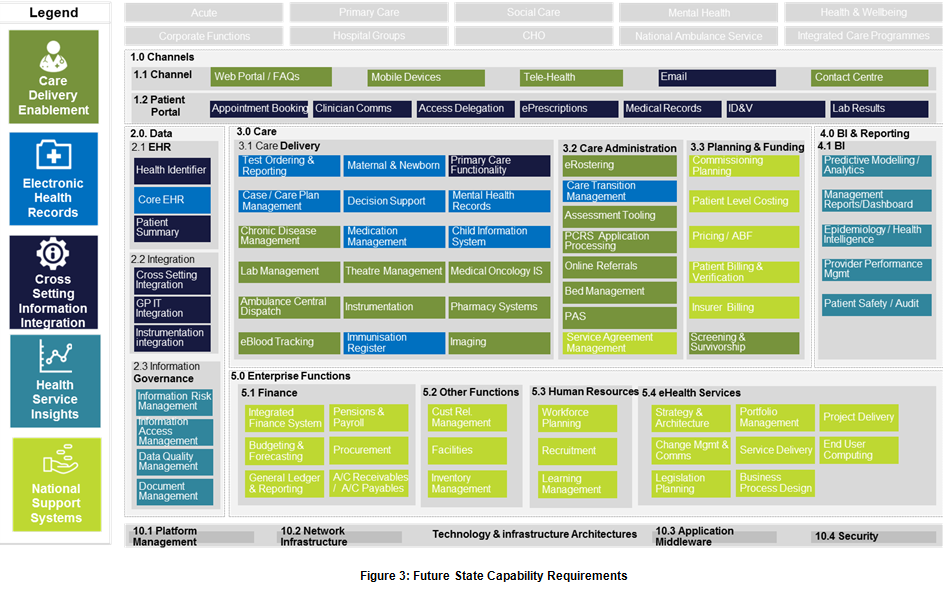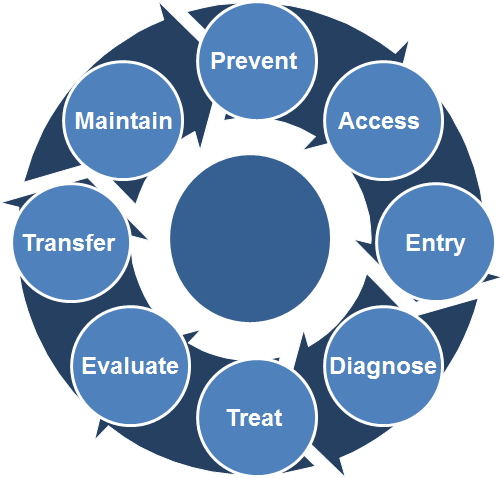Key Capability Areas
The capability requirements to deliver this experience were identified through engagement with the HSE National Directors, and distilled into five focus areas, which support the delivery of the overall reform agenda. The five focus areas are highlighted in Figure 2 below, supported by the critical enablers for a successful delivery – effective clinical and information governance, and the transformation of the Knowledge & Information function itself.
While other valuable initiatives will be identified, assessed and delivered over time in parallel to the implementation of this strategy, we are setting our focus now on capabilities which are expected to have the greatest impact across the service.
The focus areas identified in Figure 2 are described in more detail below.This distilled view is underpinned by a more detailed map of capability requirements, shown on the next page in Figure 3. The detailed capability requirements captured from each National Director are included in the appendix to this document. The five focus areas outlined here will also be referenced throughout this strategy, creating an explicit lineage between the capability requirements, their expected outcomes and benefits, and the delivery approach to realise these. The overlaps and mutual dependencies between these capabilities and their impacts are also recognised – international experience shows that a holistic, connected approach is at the heart of successful eHealth transformations.
|
Patient centric seamless care delivered across all integrated care pathways and all stages of delivery care |
|
|
5 focus areas summarising the capability requirements identified in engagement with HSE Leadership and Clinicians |
|
|
Enabling the delivery of the capability requirements through the transformation of the K&I function |
Cross Setting Information Integration
This capability delivers the required integration, information flows and process standardisation across care settings that reflect the patient care pathway, enabling the summary care record at a patient level, seamless transition between settings supported by secure handovers of patient information.
- Patients will have an Individual Health Identifier (IHI), unique to them throughout their lifetime and across all healthcare settings
- Care providers and care facilities will also have a similar unique identifier, enabling their mapping back to the patient throughout integrated care pathways
- Standardised business processes and rules for data integration so that interoperability and data sharing are enabled across all care settings
- Security & access processes and controls to support this increased level of data access and sharing
Electronic Health Records
This capability creates and enriches the patients’ electronic health records at each setting, stores the detailed care information at activity level, and feeds the summary care record to enable cross setting integration.
- Electronic record of all patient interactions with care services – capability covering hospitals, community care, social care, health & wellbeing and mental health
- Specific activities captured include ePrescribing, test ordering, care plans and transition management
- Reduced dependence on paper records on forms through introduction of clinical documentation and workflow functionality
- Decision support capabilities to provide contextual information to assist clinicians to make decisions
- Patient facing capabilities (e.g. a patient portal) to enable health information exchange, helping patients to manage their care supported by clinicians sharing knowledge and information.
Care Delivery Enablement
This capability delivers a series of clinical and care delivery capabilities which digitise areas/processes thereby allowing electronic data capture, better quality of care, more clinician time spent with patients and greater ability for patients to participate in their own care.
- Technology enabled function specific capabilities that support care delivery – a series of national programmes across the health service
- Examples include Lab Systems, Radiology tooling, ePrescribing for primary care, Appointment management and eReferral systems (all of which have care and efficiency benefits)
- Information and functionality can also be made available directly to patients through a patient portal to allow the patient to manage their own care and interact with clinicians
- Can be implemented in parallel to and later integrated with EHR
National Support Systems
This capability provides the national backbone for the core support service – finance, procurement, and HR – it is crucial for integrated, efficient management of the health system as a whole.
- Consolidated national finance solution including accounting, reporting, budgeting and forecasting, billing, and procurement
- Enablement for activity based funding (patient level costing of healthcare delivery)
- Human resource management, payroll & pensions, and learning management
Health Service Insight
This capability delivers the information management, reporting and analysis solutions and processes which provide timely, reliable information and decision support for patients, clinicians, and management from the micro level (e.g. individual patients or treatments) up to the macro view (e.g. system wide performance, population health trends).
- A comprehensive data repository allowing consolidation and flexible manipulation of data from disparate data sources – a ’single source of truth’
- Business intelligence tooling allowing rapid and flexible production of backward and forward looking management information and analytics
- Tactical BI enhancements to provide short to medium term management information to support operational management.

Capability Contribution towards Integrated Care
Delivery of each of the core capabilities outlined above makes a significant contribution towards realising the eHealth vision. Figure 4 below illustrates the relative magnitude of impact of each capability on the different stages of integrated care delivery.
Figure 4: Impact of Priority Capabilities

| Prevent | Access | Entry | Diagnose | Treat | Evaluate | Transfer | Maintain | |
|---|---|---|---|---|---|---|---|---|
| Care Delivery Enablement |
 |
 |
 |
 |
 |
 |
 |
 |
|
Electronic Health Records
|
 |
 |
 |
 |
 |
 |
 |
 |
| Cross Setting Information Integration |
 |
 |
 |
 |
 |
 |
 |
 |
| Health Service Insights |
 |
 |
 |
 |
 |
 |
 |
 |
| National Support Systems |
 |
 |
 |
 |
 |
 |
 |
 |




Very High Impact High Impact Medium Impact Low Impact
These capabilities will unlock wide-ranging benefits across all stakeholders of the healthcare system. A non-exhaustive selection of the outcomes is highlighted below, from key stakeholder perspective where the term patient encompasses any person who uses any healthcare service, care providers covers the delivery of healthcare across all care settings and the health system entails the overall national structures and management of healthcare in Ireland.
| Capability | Patient | Care Providers | Health System |
|---|---|---|---|
|
Care Delivery Enablement |
Better quality of care and a seamless patient experience
More flexible care experience and ability to self service
|
Greater clinical efficiency and quality
More efficient management of clinical and other resources
More flexible and timely integrated care delivery
Reduced risk
|
More clinical and administrational data, to allow better planning and management
Enabling system-level efficiencies
|
|
Capability |
Patient |
Care Providers |
Health System |
|---|---|---|---|
|
|
Better quality patient care and patient experience across all stages of care
Increased ability for self-care
|
Better clinical outcomes
More efficient care delivery
More effective risk management
Greater degree of care delivered in the community
|
Better quality of care
Better management of healthcare resources:
|
|
Capability |
Patient |
Care Providers |
Health System |
|---|---|---|---|
|
|
More patient involvement in own care planning and delivery
Easier access to care
Better patient care experience
Improved patient safety & security
More timely transition to convenient & appropriate care setting
|
Improved patient safety and quality of care
More efficient management of scarce resources
Enabling and transferring care from acute hospitals to community care settings
|
Improved population health
Greater focus on prevention
More effective and efficient overall care delivery and planning
|
|
Capability |
Patient |
Care Providers |
Health System |
|---|---|---|---|
|
|
Better quality of care
Greater access to care
|
More holistic view of care delivery and impacts, driving better patient care
More effective and predictive resource management, leading to greater access to care
More advanced clinical research and analysis
|
More comprehensive and accurate planning of national trends and service requirements
More effective care delivery
|
|
Capability |
Patient |
Care Providers |
Health System |
|---|---|---|---|
|
|
Greater access to care
|
More proactive and effective resource planning and allocation, leading to greater access to care
More care delivered through the community
More accurate, granular financial management and planning
|
More efficient short and long term resource planning & management
Healthcare funding model aligned to strategy
More proactive financial management of the health system
|
The capabilities described above will result in a fundamentally more ‘user friendly’ experience for all stakeholders of the health service. A selection of future experiences are highlighted below in Figure 5, to illustrate the ‘look and feel’ of the eHealth enabled care delivery system.
|
Key eHealth User Experiences |
||||
|
Patient
|
“I don’t have to provide all of my information again and again” - Electronic Health Records |
“I don’t have to go to the doctor as much as I used to. Now I just do the tests at home” - Care Delivery Enablement |
“I can check my medical records online to check how something was treated before” - Cross Setting Information Integration |
“I can request prescription, appointments and check results from home” - Cross Setting Information Integration |
|
Hospital Doctor
|
“I can see my patients medical history, regardless of where treatment took place” - Electronic Health Records |
“I can consult support tools to help me make a decision” - Electronic Health Records |
“I can request tests and issue prescriptions electronically, saving critical time” - Electronic Health Records |
“Funding for my service is responsive to the number of patients needing my help” - National Support Systems |
|
Community Nurse
|
“I can see my patients medical history, regardless of where treatment took place” - Electronic Health Records |
“Collaborating with my colleagues is now easier as we can share and update care plans” - Electronic Health Records |
“I have my tools available on my mobile when out visiting patients” - Care Delivery Enablement |
“I can submit test requests and referrals to others electronically” - Electronic Health Records |
|
Physiotherapist
|
“My time is well utilised as referrals and bookings happen electronically” - Care Delivery Enablement |
“I can capture my patient notes as I go on my tablet in the treatment room” - Care Delivery Enablement |
“I can check how my patients are doing as they log their progress on the portal” - Cross Setting Information Integration |
“I can update my colleagues who are also treating my patients” - Electronic Health Records |
|
Hospital Group Manager
|
“I can manage my beds more effectively as I can predict how many will be free” -Health Service Insights |
“I can see resource availability across my hospital group and reallocate resources or patients as required” - National Support Systems |
“I can manage patient safety closely with detailed reports on clinical trends” -Health Service Insights |
“I can review performance across all of my hospitals to see where needs improvement” -Health Service Insights |
|
GP
|
“I can electronically refer my patients to specialists” - Electronic Health Records |
“I can securely communicate with my patients and other health professionals” - Cross Setting Information Integration |
“I can see my patient medical history including hospital prescriptions, discharge summaries and lab reports” - Electronic Health Records |
“I can help my patients manage their chronic illnesses through telehealth devices” - Care Delivery Enablement |







